Demonstracijske ploskve
Project actions are carried out on 30 demonstration sites distributed into:
⦁ 3 European Countries: Croatia, Italy, Slovenia;
⦁ 4 forest tree genus: Abies, Fagus, Pinus, Quercus;
⦁ 8 forest tree species: silver fir (Abies alba); european beech (Fagus sylvatica); black pine (Pinus nigra); Italian stone pine (Pinus pinea); maritime pine (Pinus pinaster); downy oak (Quercus pubescens); pedunculate oak (Quercus robur); holm oak (Quercus ilex)
⦁ 13 European forest types: Alpine Scots pine and Black pine forest; Apennine-Corsican mountainous beech forest; Central European mountainous beech forest; Downy oak forest; Illyrian mountainous beech forest; Illyrian submountainous beech forest; Mediterranean and Anatolian Black pine forest; Mediterranean and Anatolian fir forest; Mediterranean evergreen oak forest; Mediterranean pine forest; Pedunculate oak-hornbeam forest; Plantations of site-native species; Subalpine and mountainous spruce and mountainous mixed spruce-silver fir forest;
⦁ 20 sites of the Natura2000 network: 10 Special Protection Areas (SPAs) and 10 Special Areas of Conservation (SACs).
The main project activities implemented in these sites are related to Actions B1, B2, and B3.
Forest tree species: Fagus sylvatica
EFT: Apennine‑Corsican mountainous beech forest
The demonstration site is located in the National Nature Reserve of “Pian degli Ontani”, which is a public owned forest managed by Raggruppamento Carabinieri Biodiversità di Pistoia. The Reserve falls within a SPA of the Natura 2000 Network named “Pian degli Ontani” (code IT5130004). The Reserve extends on 591 ha at an altitude ranging between 1100 and 1770 m a.s.l.; the ground rock material is composed by silicate rocks, and the soil is acid brown. The project demonstration site is located within the forest unit num. 468, at an altitude of 1220 m a.s.l.; the area of the forest unit is 2.4 ha. Fagus sylvatica is the dominant forest tree species inside the Reserve, covering 86% of total forest area; other species are Abies alba, Picea abies, Sorbus aucuparia, Acer pseudoplatanus, Laburnum anagyroides, Salix caprea, Betula pendula, Sambucus racemosa, Castanea sativa, Pseudotsuga menziesii, Larix decidua, Pinus nigra, and Pinus sylvestris. In the demonstration site the forest is a pure stand of Fagus sylvatica; according to the European forest type classification, the site is classified as “Apennine‑Corsican mountainous beech forest” (EFT 7.3). The demonstration site is an even-aged stand managed by the uniform shelterwood system with a rotation age of 120 years and a regeneration period of 30 years. The forest is 50-60 years old; the structure is characterize by a single layered canopy; the num. of trees/ha (dbh>2.5 cm) is of 624 trees, the basal area is of 31 m2/ha, the wood volume is of 374 m3/ha, the quadratic mean diameter is of 25 cm, the average height is of 21.8 m, and the top height is of 22.7 m.






Forest tree species: Fagus sylvatica
EFT: Apennine‑Corsican mountainous beech forest
The Baldo’s Forest is a private owned forest managed by Baldo’s family that have been handed down from father to son since the XIX century. Part of the study area falls within a SPA of the Natura 2000 Network named “Pian degli Ontani” (code IT5130004). The private owned forest extends on 10 ha at an altitude ranging between 1000 and 1200 m a.s.l.; the ground rock material is composed by silicate rocks, and the soil is acid brown. The project demonstration site is a pure stand of Fagus sylvatica located at an altitude of 1200 m a.s.l.; according to the European forest type classification, the site is classified as “Apennine‑Corsican mountainous beech forest” (EFT 7.3). The Baldo’s Forest is an uneven-aged forest managed with a type of single tree selection felling carried out according to local traditional knowledge; the cut is done every 5-6 years and the plants to be cut are chosen according to the size and technological characteristics of the stem and to the needs of the regeneration. The structure is typical of a multilayered uneven-aged stand, with three or more tree layers; the num. of trees/ha (dbh>2.5 cm) is of 2184 trees, the basal area is of 30 m2/ha, the wood volume is of 305 m3/ha, the quadratic mean diameter is of 14 cm, the average height is of 16,48 m, and the top height is of 29 m.




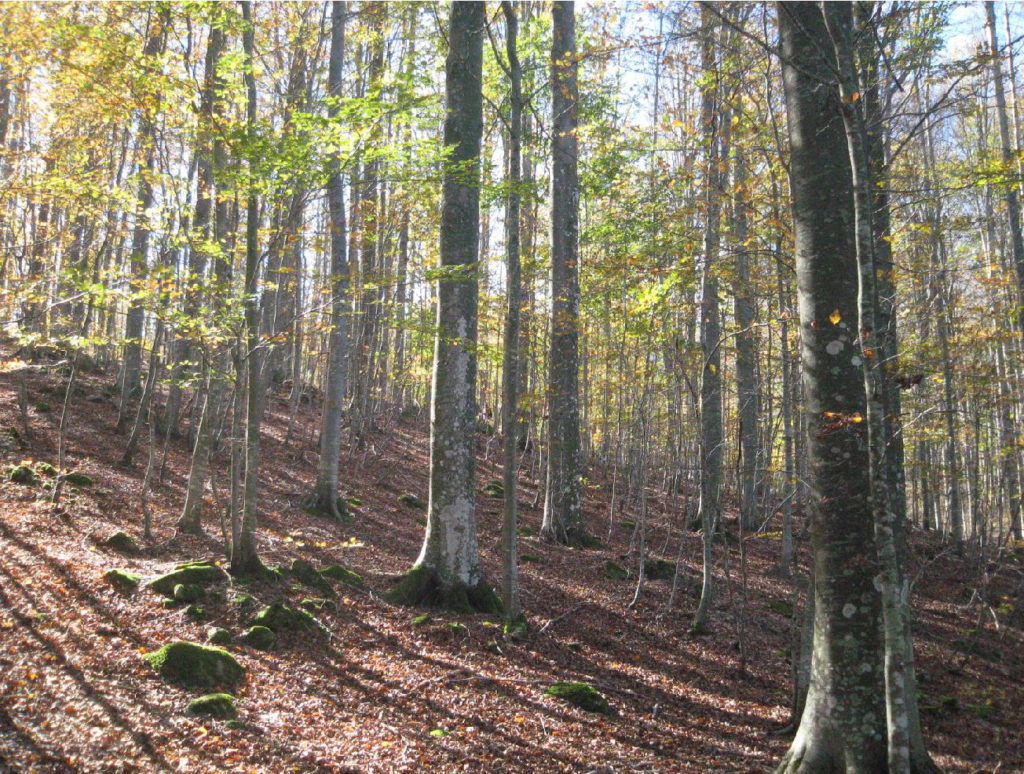



Forest tree species: Fagus sylvatica
EFT: Apennine‑Corsican mountainous beech forest
“Pratomagno-Casentino” is a public forest district owned by Tuscany Region managed by Unione dei Comuni Montani del Casentino. The forest district extends on 3420 ha at an altitude ranging between 620 and 1595 m a.s.l.; the soil is classified as Ultic Hapludalfs, fine‐loamy, mixed, mesic. The project demonstration site is located within the forest unit num. A 35/3, at an altitude of 1450 m a.s.l.; the area of the forest unit is 9.94 ha. Fagus sylvatica is the dominant forest tree species inside the demonstration site; according to the European forest type classification, the site is classified as “Apennine‑Corsican mountainous beech forest” (EFT 7.3). The forest in the demonstration site is an even-aged stand managed by uniform shelterwood system. The structure is characterized by one-two layers; the num. of trees/ha (dbh>2.5 cm) is of 300-600 trees, the quadratic mean diameter is of 32 cm, the average height is of 25 m, and the top height is of 30 m.


Forest tree species: Fagus sylvatica
EFT: Apennine‑Corsican mountainous beech forest
“Alpe di Catenaia” is a public forest district owned by Tuscany Region and managed by Unione dei Comuni Montani del Casentino. The forest district extends on 2341 ha at an altitude ranging between 620 and 1600 m a.s.l.; the soil is classified as Ultic Hapludalfs, fine‐loamy, mixed, mesic. The project demonstration site is located within the forest unit num. C 27/5, at an altitude ranging between 1010 and 1155 m a.s.l.; the area of the forest unit is 2.10 ha. Fagus sylvatica L. is the dominant forest tree species inside the demonstration site; according to the European forest type classification, the site is classified as “Apennine‑Corsican mountainous beech forest” (EFT 7.3).
The forest in the demonstration site is an even-aged stand managed by uniform shelterwood system. In the site, the seed cut and the removal cut were carried out in 2002 and 2018, respectively. After the cuts the regeneration of beech is establishing. Thus, the structure of the young even-aged stand is characterized by a dense one-layered canopy.




Forest tree species: Fagus sylvatica
EFT: Apennine‑Corsican mountainous beech forest
“Alpe di Catenaia” is a public forest district owned by Tuscany Region and managed by Unione dei Comuni Montani del Casentino. The forest district extends on 2341 ha at an altitude ranging between 620 and 1600 m a.s.l.; the soil is classified as Ultic Hapludalfs, fine ‐loamy, mixed, mesic. The project demonstration site is located within the forest unit num. C 50/3, at an altitude ranging between 1090 and 1115 m a.s.l.; the area of the forest unit is 3.19 ha. Fagus sylvatica L. is the dominant forest tree species inside the demonstration site; according to the European forest type classification, the site is classified as “Apennine‑Corsican mountainous beech forest” (EFT 7.3).
The forest in the demonstration site is an even-aged stand managed by uniform shelterwood system. In the site, the seed cut was carried out in 2017, and after the cut the regeneration of beech is establishing. Thus, the structure is characterize by a two-layered canopy, with the old stand in the upper layer and the regeneration in the below layer; the num. of trees (dbh>2.5 cm) is of 150-300 trees/ha, the wood volume is of 200-250 m3/ha the quadratic mean diameter is of 40 cm, the average height is of 20 m, and the top height is of 30 m.
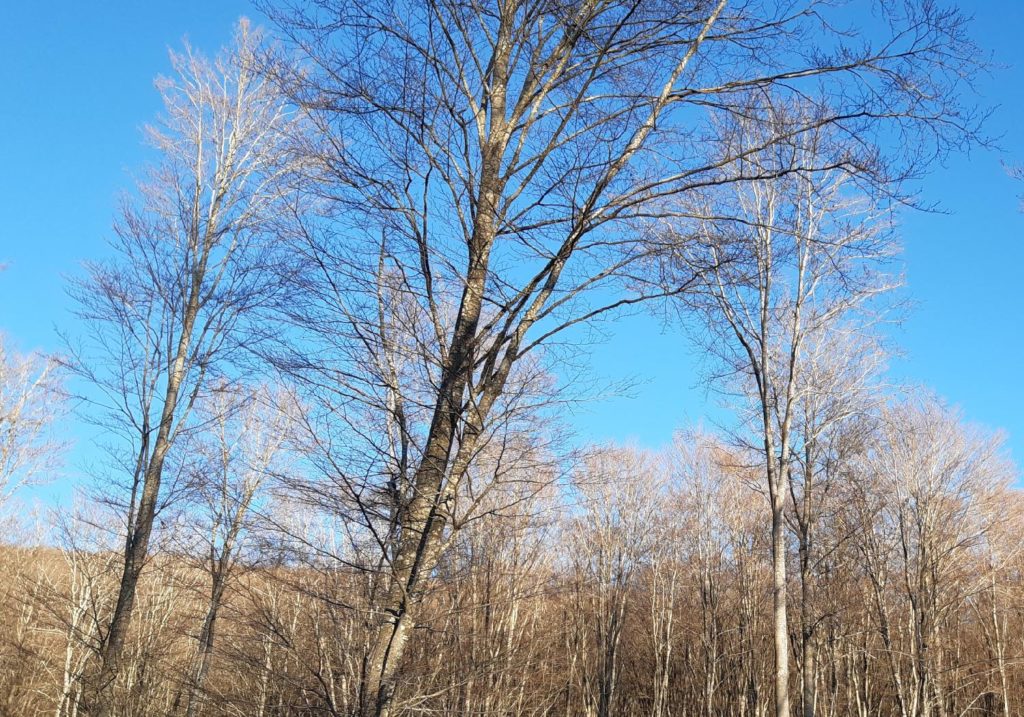



Forest tree species: Abies alba
EFT: Mediterranean and Anatolian fir forest
“Alpe di Catenaia” is a public forest district owned by Tuscany Region and managed by Unione dei Comuni Montani del Casentino. The forest district extends on 2341 ha at an altitude ranging between 620 and 1600 m a.s.l.; the soil is classified as Ultic Hapludalfs, fine‐loamy, mixed, mesic. The project demonstration site is located within the forest unit num. C 73/1, at an altitude of 1067 m a.s.l.; the area of the forest unit is 2.88 ha. Abies alba is the dominant forest tree species inside the demonstration site; other important forest tree species are Fagus sylvatica and Salix caprea; according to the European forest type classification, the site is classified as “Mediterranean and Anatolian fir forest” (EFT 10.6). The forest in the demonstration site is a very dense young even-aged stand (15-25 years old) originated by clear cutting. The structure is characterize by two layers; the num. of trees/ha (dbh>2.5 cm) is of 1200-1500 trees, the quadratic mean diameter is of 10 cm, the average height is of 9 m, and the top height is of 13 m.


Forest tree species: Abies alba Mill.
EFT: Apennine‑Corsican mountainous beech forest
“Alpe di Catenaia” is a public forest district owned by Tuscany Region and managed by Unione dei Comuni Montani del Casentino. The forest district extends on 2341 ha at an altitude ranging between 620 and 1600 m a.s.l.; the soil is classified as Ultic Hapludalfs, fine‐loamy, mixed, mesic. The project demonstration site is located within the forest unit num. D 10/1, at an altitude of 1100 m a.s.l.; the area of the forest unit is 1.78 ha. Fagus sylvatica L. and Quercus cerris L. are the dominant forest tree species inside the demonstration site, with small groups of Abies alba Mill.; according to the European forest type classification, the site is classified as “Apennine‑Corsican mountainous beech forest” (EFT 7.3).
The forest in the demonstration site is an even-aged stand managed by uniform shelterwood system, with some plantations of Abies alba Mill. (40 years old) and natural regeneration. The num. of trees (dbh>2.5 cm) is of 900-1200 trees/ha, the wood volume is of 300-400 m3/ha the quadratic mean diameter is of 24 cm, the average height is of 18 m, and the top height is of 25 m.




Forest tree species: Pinus pinea L.
EFT: Mediterranean pine forest
The demonstration site is located in the Migliarino, San Rossore, Massaciuccoli Regional Park, which is a public property owned by Tuscany Region and managed by Park. The study area falls within a SAC and a SPA of the Natura 2000 Network, both named “Selva Pisana” (code IT5170002). The demonstration site is located within the forest unit num. 139, at an altitude of 2 m a.s.l.; the area of the forest unit is 12.20 ha. The forest grows on a sandy soil. Pinus pinea is the dominant forest tree species inside the demonstration site; according to the European forest type classification, the site is classified as “Mediterranean pine forest” (EFT 10.1). The forest in the demonstration site is an even-aged stand (105 years old) managed by clearcut system and planting. The rotation age is of 90 years. The structure is characterize by a single layered canopy; the num. of trees/ha (dbh>2.5 cm) is of 104 trees, the basal area is of 22 m2/ha, the wood volume is of 326 m3/ha, the quadratic mean diameter is of 52,7 cm.




Forest tree species: Pinus pinea L.
EFT: Mediterranean pine forest
The demonstration site is located in the Migliarino, San Rossore, Massaciuccoli Regional Park, which is a public property owned by Tuscany Region and managed by Park. The study area falls within a SAC and a SPA of the Natura 2000 Network, both named “Selva Pisana” (code IT5170002). The demonstration site is located within the forest unit num. 27, at an altitude of 2 m a.s.l.; the area of the forest unit is 9 ha. The stand grows on a sandy soil. Pinus pinea is the dominant forest tree species inside the demonstration site; according to the European forest type classification, the site is classified as “Mediterranean pine forest” (EFT 10.1). The forest in the demonstration site is an even-aged (103 years old) stand managed by clearcut system and planting. The rotation age is of 90 years. The structure is characterize by a single layered canopy; the num. of trees/ha (dbh>2.5 cm) is of 99 trees, the basal area is of 28.6 m2/ha, the wood volume is of 458 m3/ha, the quadratic mean diameter is of 60.7 cm.




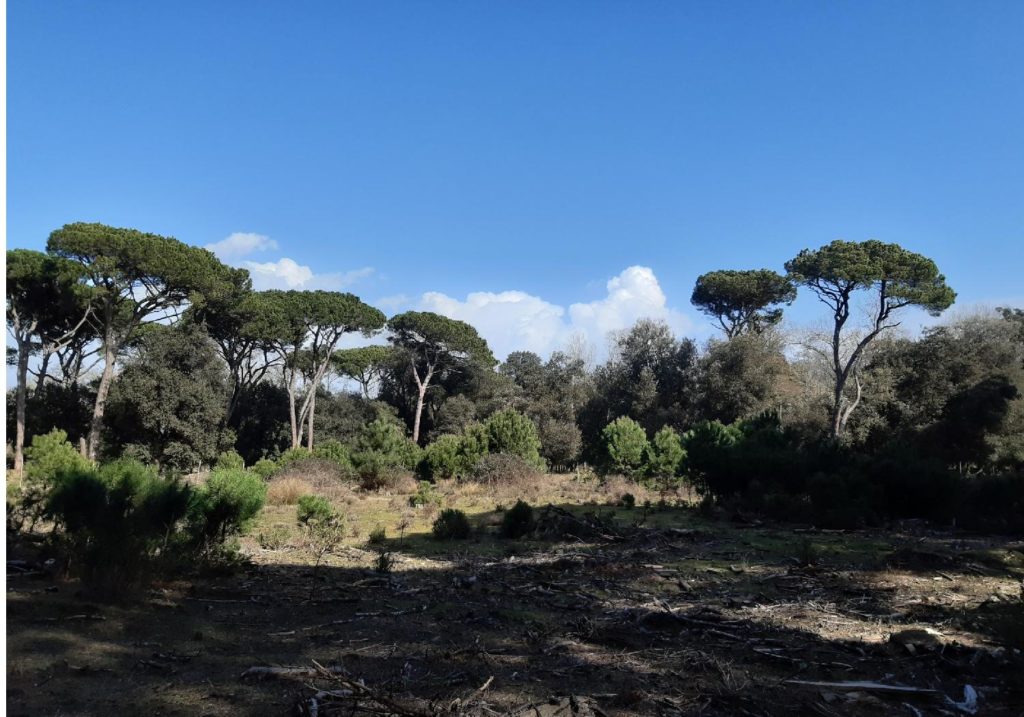

Forest tree species: Quercus robur L.
EFT: Pedunculate oak-hornbeam forest
The demonstration site is located in the Migliarino, San Rossore, Massaciuccoli Regional Park, which is a public property owned by Tuscany Region and managed by Park. The study area falls within a SAC and a SPA of the Natura 2000 Network, both named “Selva Pisana” (code IT5170002). The demonstration site is located within the forest unit num. 386, at an altitude of 2 m a.s.l.; the area of the forest unit is 29.2 ha. The forest grows on alluvial soils. The site is a mixed broadleaved forest dominated by Quercus robur, Fraxinus angustifolia and Populus alba; other forest tree species are Acer campestre, Ulmus minor and Crataegus monogyna; according to the European forest type classification, the site is classified as “Pedunculate oak-hornbeam forest” (EFT 5.1). The forest in the demonstration site is an unmanaged uneven-aged stand. The structure is typical of a multilayered uneven-aged stand, with three or more tree layers; the num. of trees/ha (dbh>2.5 cm) is of 608 trees, the basal area is of 27.9 m2/ha, the wood volume is of 367.5 m3/ha.




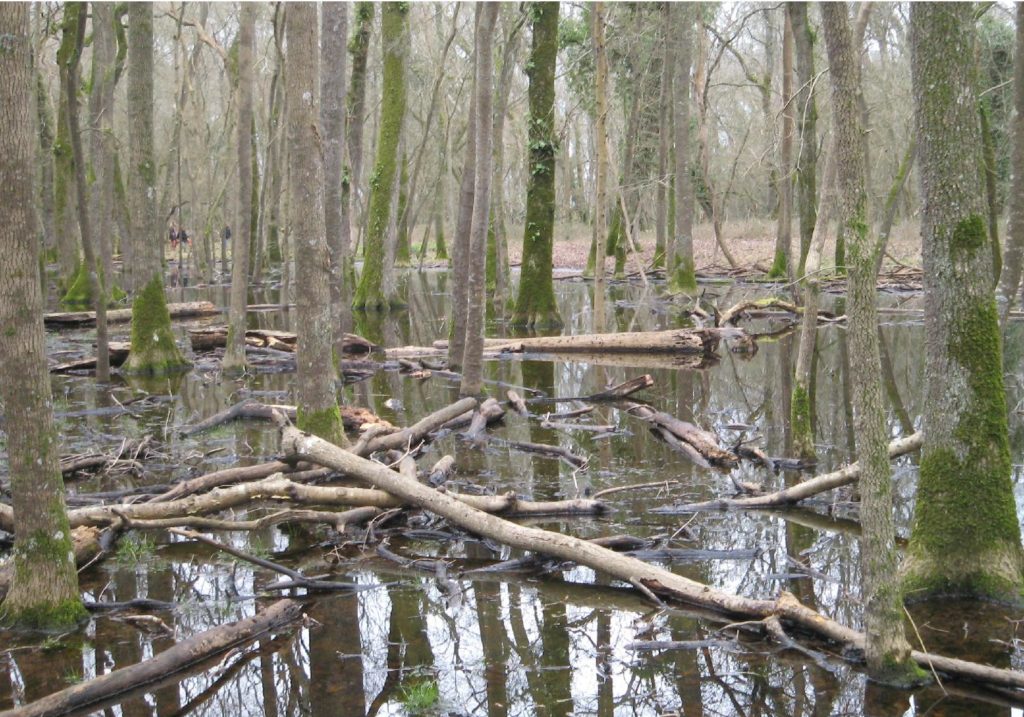

Forest tree species: Fagus sylvatica
EFT: Apennine‑Corsican mountainous beech forest
Fonte Novello is a public owned forest managed by Gran Sasso-Laga National Park. The study area falls within a SAC and a SPA of the Natura 2000 Network named “Gran Sasso” (code IT7110202) and “Parco Nazionale Gran Sasso – Monti della Laga” (code IT7110128), respectively. The demonstration site is located at an altitude ranging between 1100 and 1400 m a.s.l.; the ground rock material is composed by calcareous rock and the soil is a Lithic Rendolls. Fagus sylvatica is the dominant forest tree species inside the demonstration site; according to the European forest type classification, the site is classified as “Apennine‑Corsican mountainous beech forest” (EFT 7.3). The demonstration site is an unmanaged old-growth beech forest (average age of 207 years), which has not been harvested during the last 400 years. The structure is characterize by a multilayered canopy; the num. of trees/ha (dbh>2.5 cm) is of 184 trees, the basal area is of 58 m2/ha, the wood volume is of 1079 m3/ha.
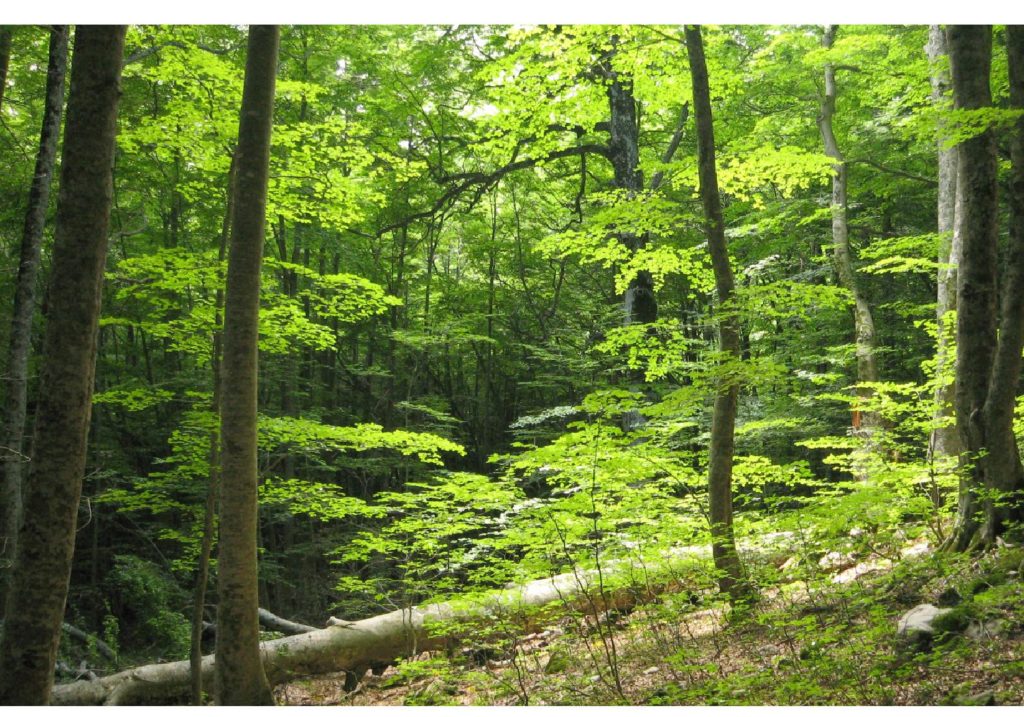





Forest tree species: Fagus sylvatica L.
EFT: Apennine‑Corsican mountainous beech forest
Venacquaro Forest is a public owned forest managed by Gran Sasso-Laga National Park. The study area falls within a SAC and a SPA of the Natura 2000 Network named “Gran Sasso” (code IT7110202) and “Parco Nazionale Gran Sasso – Monti della Laga” (code IT7110128), respectively. The demonstration site is located at an altitude ranging between 1100 and 1400 m a.s.l.; the ground rock material is composed by calcareous rock and the soil is a Lithic Rendolls. Fagus sylvatica is the dominant forest tree species inside demonstration site; according to the European forest type classification, the site is classified as “Apennine‑Corsican mountainous beech forest” (EFT 7.3). The demonstration site is an even-aged (85 years old) stand, where forest management aim is the conversion from coppice to high forest by means of thinning from below and regeneration felling carried out according to the uniform shelterwood system. The structure is characterize by a two-layered canopy; the num. of trees/ha (dbh>2.5 cm) is of 496 trees, the basal area is of 30 m2/ha, the wood volume is of 403 m3/ha.






Forest tree species: Quercus robur
EFT: Pedunculate oak-hornbeam forest
Stara Gradiška is a public owned forest managed by state-owned company “Croatian Forests Ltd”. The forest extends on 82.8 ha at an altitude of about 92 m a.s.l.; the soil is amphigley, humogley, and pseudogley. Quercur robur is the dominant forest tree species inside the demonstration site; other three species are Fraxinus angustifolia, Carpinus betulus, Alnus glutinosa and other hard deciduous trees; according to the European forest type classification, the site is classified as “Pedunculate oak-hornbeam forest” (EFT 5.1). The forest in the demonstration site is unmanaged (Forest seed object) and has an average age of 148 years; the num. of trees/ha (dbh>2.5 cm) is of 1012 trees, the wood volume is of 2344.8 m3/ha.






Forest tree species: Fagus sylvatica L.
EFT: Central European mountainous beech forest
Ogulin is a public owned forest managed by state-owned company “Croatian Forests Ltd”. The study area falls within a SAC of the Natura 2000 Network named “Područje oko Kuštrovke” (code HR2001340). The forest extends on 21.2 ha at an altitude ranging between 380 and 440 m a.s.l.; the soil is a kalcikambisol. Fagus sylvatica is the dominant forest tree species inside the demonstration site; other species are Acer pseudoplatanus and other hard deciduous trees; according to the European forest type classification, the site is classified as “Central European mountainous beech forest” (EFT 7.2). The forest in the demonstration site is unmanaged (Forest seed object) and has an average age of 125 years; the num. of trees/ha (dbh>2.5 cm) is of 535 trees, the wood volume is of 1266.0 m3/ha.
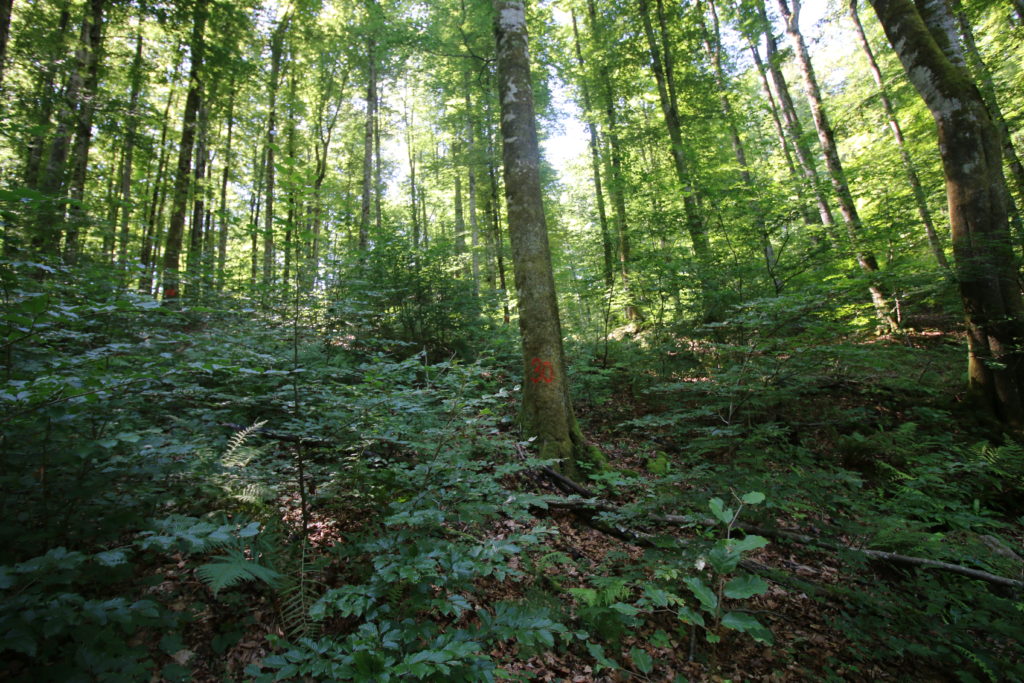





Forest tree species: Pinus pinea L.
EFT: Mediterranean pine forest
Zadar is a public owned forest managed by state-owned company “Croatian Forests Ltd”. The study area falls within a SPA of the Natura 2000 Network named “Ravni kotari” (code HR1000024). The forest extended on 26.8 ha before a fire occurred (after fire extends on 2.1 ha), at an altitude ranging between 73 and 75 m a.s.l.; the soil is “rendzina”. Pinus pinea was the dominant tree species before fire, but after fire Pinus halepensis is the prevalent species; other species are hard deciduous trees; according to the European forest type classification, the demonstration site is classified as “Mediterranean pine forest” (EFT 10.1). The forest in the demonstration site is uneven-aged stand and is managed with a single tree selection system.


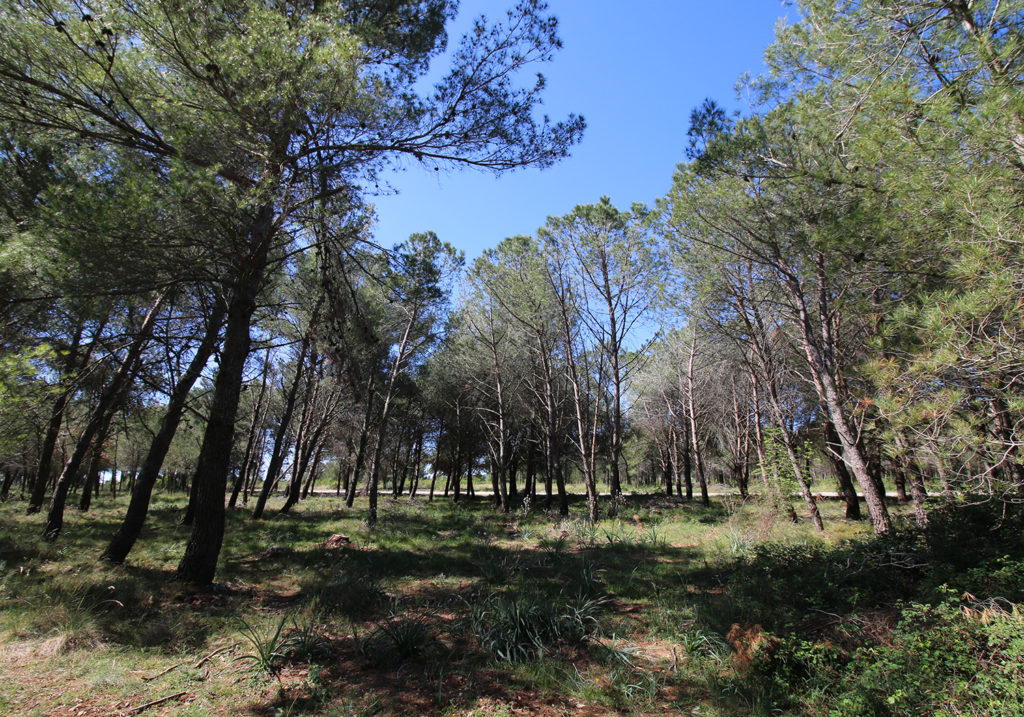

Forest tree species: Abies alba Mill.
EFT: Subalpine and mountainous spruce and mountainous mixed spruce-silver
Skrad is a public owned forest managed by state-owned company “Croatian Forests Ltd”. The forest extends on 35.0 ha at an altitude of 530 m a.s.l.; the soil is “podzolic brown”. Abies alba is the dominant forest tree species inside the demonstration site; other species are Fagus sylvatica, Picea abies and other hard deciduous trees; according to the European forest type classification, the site is classified as “Subalpine and mountainous spruce and mountainous mixed spruce-silver” (EFT 3.2).
The forest in the demonstration site has an average age of 140 years and is unmanaged (Forest seed object). The structure is characterize by two-layered canopy; the num. of trees/ha (dbh>2.5 cm) is of 776 trees.




Forest tree species: Pinus nigra J.F. Arnold
EFT: Alpine Scots pine and Black pine forest
Klana is a public owned forest managed by state-owned company “Croatian Forests Ltd”. The forest extends on 10.9 ha at an altitude ranging between 580 and 650 m a.s.l.; the soil is “brown soil on limestone and dolomite”. Pinus nigra is the dominant forest tree species inside the demonstration site; other species are Ostrya carpinifolia, Quercus cerris, and other hard deciduous trees; according to the European forest type classification, the site is classified as “Alpine Scots pine and Black pine forest” (EFT 3.3).
The forest in the demonstration site has an average age of 123 years and is unmanaged (Forest seed object).
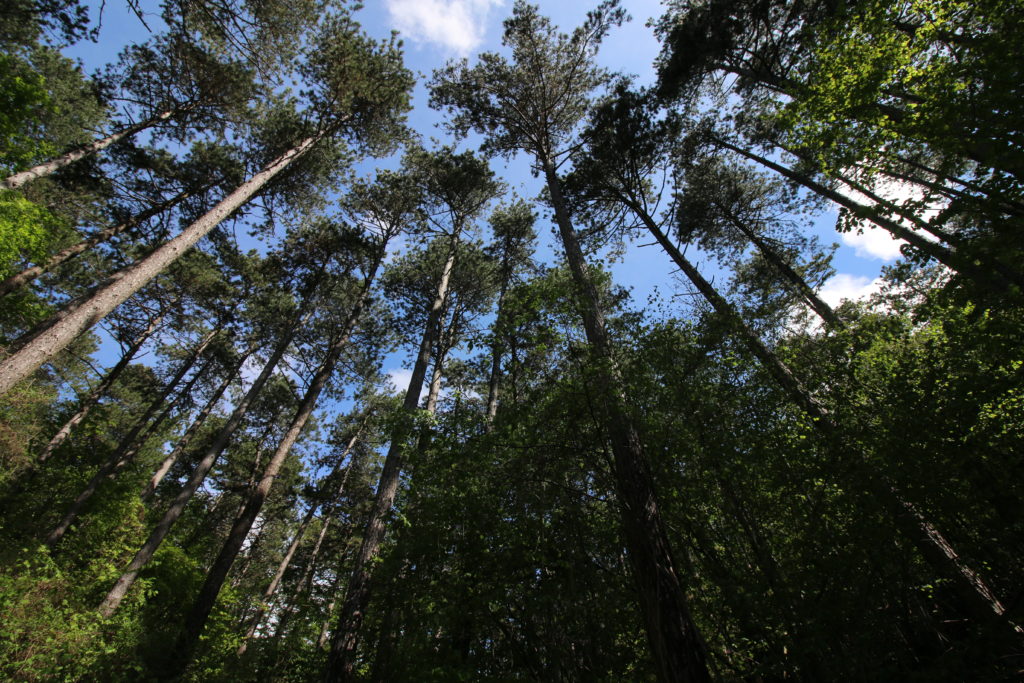



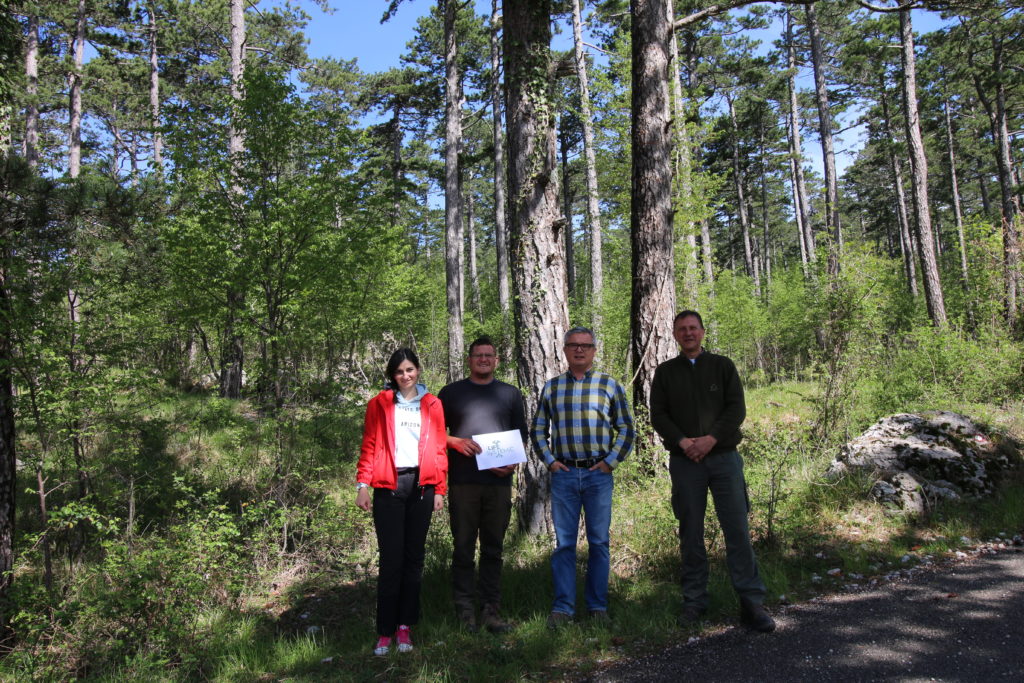

Forest tree species: Pinus nigra J.F. Arnold
EFT: Mediterranean and Anatolian Black pine forest
Brač is a public owned forest managed by state-owned company “Croatian Forests Ltd”. The study area falls within a SAC of the Natura 2000 Network named “Vidova gora” (code HR2000937). The forest extends on 62.5 ha at an altitude ranging between 500 and 610 m a.s.l.; the soil is “brown soil on limestone and dolomite”. Pinus nigra is the dominant forest tree species inside the demonstration site; according to the European forest type classification, the site is classified as “Mediterranean and Anatolian Black pine forest” (EFT 10.2).
The forest in the demonstration site has an average age of 100 years and is managed with a single tree selection system. The num. of trees/ha (dbh>2.5 cm) is of 1527 trees, the wood volume is of 551.7 m3/ha.


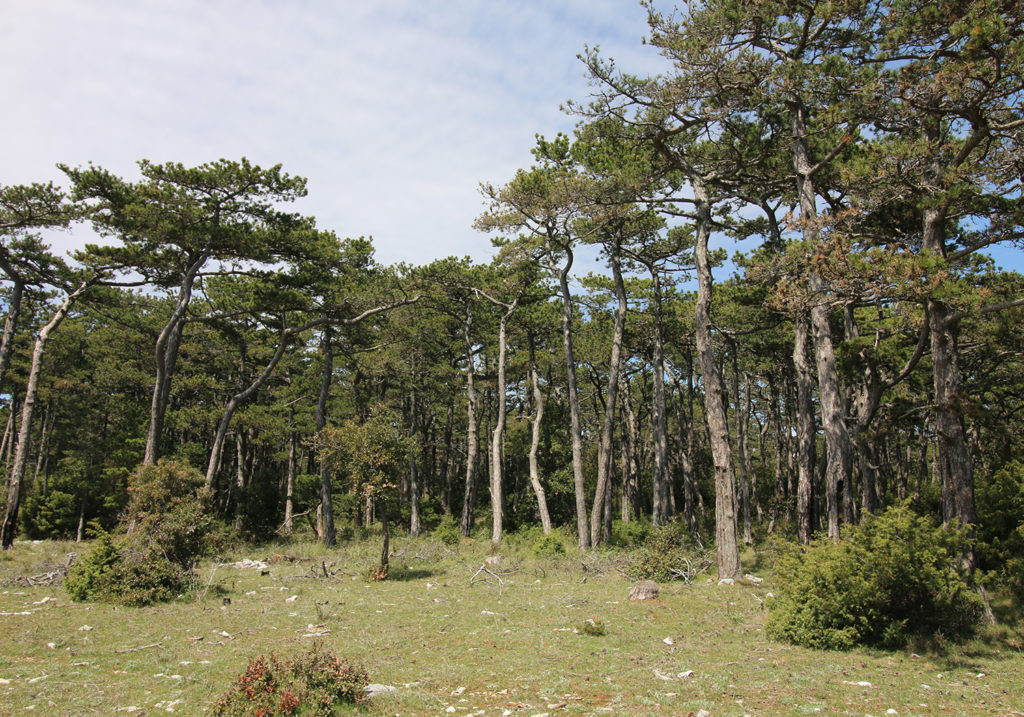





Forest tree species: Pinus pinaster Aiton
EFT: Mediterranean pine forest
Pelješa is a public owned forest managed by state-owned company “Croatian Forests Ltd”. The study area falls within a SPA of the Natura 2000 Network named “Srednjedalmatinski otoci i Pelješac” (code HR1000036). The forest extended on 20.0 ha before a fire occurred (after fire extends on 2.1 ha), at an altitude ranging between 440 and 550 m a.s.l.; the soil is “rendzina”. Pinus pinaster was the dominant tree species in the demonstration site before fire, and its natural regeneration is spreading after fire; according to the European forest type classification, the site is classified as “Mediterranean pine forest” (EFT 10.1).
The forest in the site is even-aged and is managed as a “Post fire stand”.






Forest tree species: Quercus ilex L.
EFT: Mediterranean evergreen oak forest
Pula is a public owned forest managed by state-owned company “Croatian Forests Ltd”. The study area falls within a SAC of the Natura 2000 Network named “Luka Budava – Istra” (code HR2000522). The forest extends on 15.0 ha at an altitude ranging between 2 and 15 m a.s.l.; the soil is “Terra rossa”. Quercus ilex is the dominant forest tree species inside the demonstration site; other forest species are Quercus pubescens, Laurus nobilis and other hard deciduous trees; according to the European forest type classification, the site is classified as “Mediterranean evergreen oak forest” (EFT 9.1).
The forest in the demonstration site has an average age of 55 years and is unmanaged (Forest seed object). The num. of trees/ha (dbh>2.5 cm) is of 1615 trees, the wood volume is of 183.4 m3/ha.
Forest tree species: Quercus pubescens Willd.
EFT: Downy oak forest
Črni Kal is a private forest with multiple owners. The study area is under the SAC (code SI3000276) and SPA (code SI5000023) of the Natura 2000 Network named “Kras”. The forest extends on 22 ha at an altitude ranging between 125 and 325 m a.s.l.; the ground rock material is limestone, and the soil is Rendzic Leptosol and Eutric Cambisols. Quercus cerris is the main tree species in the area, covering 60 %, other tree species are: O. carpinifolia (25%), P. nigra (15%). According to the European forest type classification, the demonstration site is classified as “Downy oak forest” (EFT 8.1).
The forest is managed by selective logging or coppicing.
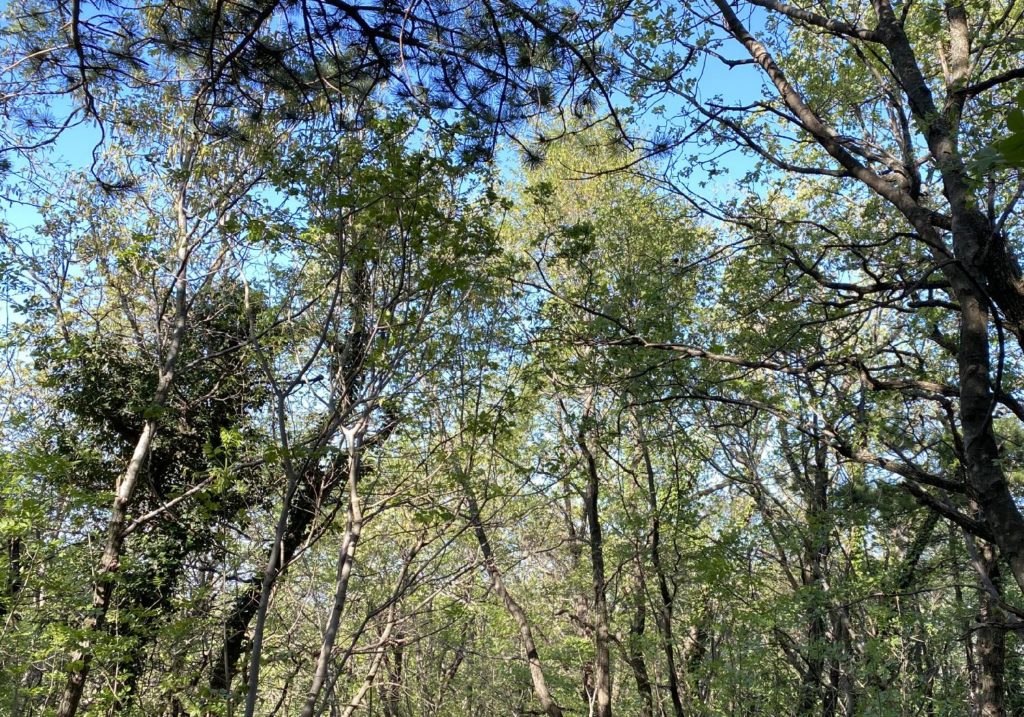

Forest tree species: Pinus nigra J.F. Arnold
EFT: Plantation of site-native species
The forest is owned by Agricultural community. The study area is under the SAC (code SI3000276) and SPA (code SI5000023) of the Natura 2000 Network named “Kras”. The area extends on 8.7 ha at an altitude of about 450 m a.s.l.; the ground rock material is limestone, and the soil is Rendzic Leptosol and Eutric Cambisols. The main species is Pinus nigra, which covers all the area (100%). It was planted in the past when reforestation of the Karst was implemented. According to the European forest type classification, the demonstration site is classified as “Plantation of site-native species” (EFT 14.1).
The forest is managed by selective thinning and seed object; it’s a 100 years old even-aged stand.


Forest tree species: Fagus sylvatica L.
EFT: Central european mountainous beech forest
State owned forest, management executed by the Slovenian national forests company (SiDG). The study area is under the SPA of the Natura 2000 Network named “Pohorje” (code SI5000006). The area extends on 8 ha at an altitude of 1240 m a.s.l.; the ground rock material is tonalite, and the soil is Dystric Cambisols. The main species is Fagus sylvatica (95%), Abies alba is present on 5% of the area. According to the European forest type classification, the demonstration site is classified as “Central european mountainous beech forest” (EFT 7.2).
The forest is managed by irregular shelterwood system (seed object, gene reserve); it’s a 110 years old even-aged stand.
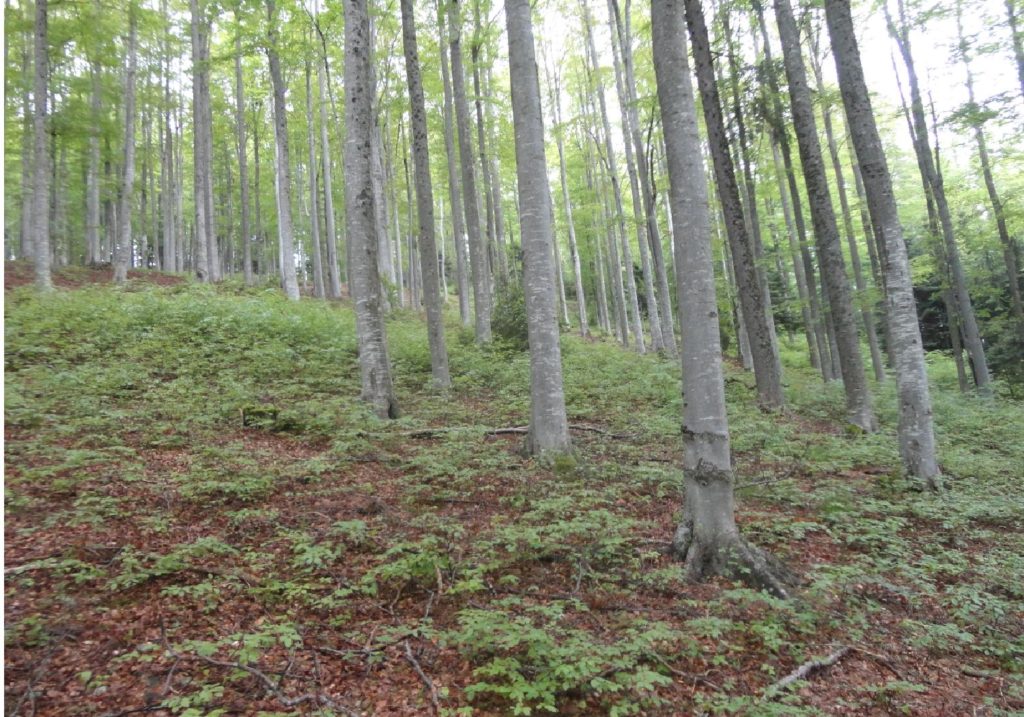



Forest tree species: Fagus sylvatica L.
EFT: Illyrian submountainous beech forest
State owned forest, management executed by the Slovenian national forests company (SiDG). The study area is under the SAC (code SI3000263) and SPA (code SI5000013) of the Natura 2000 Network named “Kočevsko”.
The forest extends on 99.8 ha at an altitude ranging between 430 and 650 m a.s.l.; the ground rock material is limestone, and the soil is Eutric Cambisols. The main species is Fagus sylvatica that covers almost all area (99%), Abies alba is present on 0,5% and Prunus avium on 0,5% of the area. According to the European forest type classification, the demonstration site is classified as “Illyrian submountainous beech forest” (EFT 6.6).
The forest is managed by irregular shelterwood system (seed object, FGM plot); the stand is beetween 80 and 100 years old.


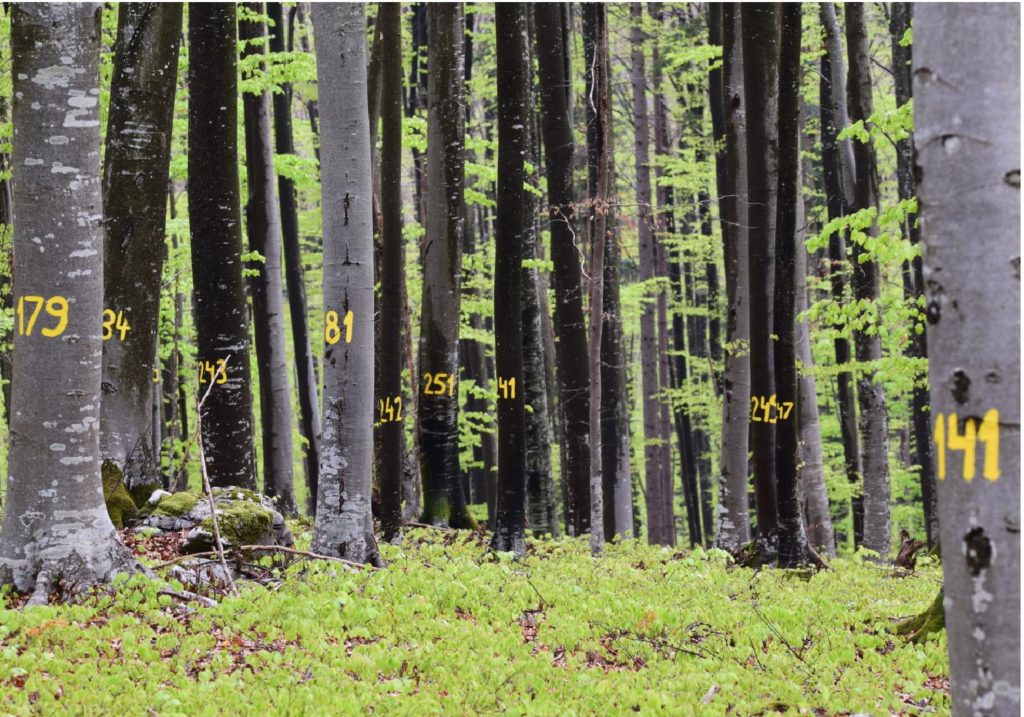



Forest tree species: Fagus sylvatica L.
EFT: Illyrian submountainous beech forest
Rajhenavski Rog is a virgin forest reserve with old growth structure owned by the state. The study area is under the SAC (code SI3000263) and SPA (code SI5000013) of the Natura 2000 Network named “Kočevsko” and no management is conducted there. The reserve is circled by two forest reserves (Rog and Dolga Gorica) where limited management is conducted. The reserve extends on 51,1 ha at an altitude ranging between 850 and 900 m a.s.l. Surrounding reserves are 96.9 ha (Rog reserve) and 17.0 ha (Dolga Gorica) large, respectively. All three reserves together measure 165 ha. The ground rock material is limestone, and the soil is Rendzic Leptosol and Eutric Cambisols. The main species is Fagus sylvatica that covers 54%, Abies alba is present on 43%, Picea abies represents 2%, and Acer pseudoplatanus 1% of the area. According to the European forest type classification, the forest is classified as “Illyrian mountainous beech forest” (EFT 7.4).
The whole forest is unmanaged (Forest reserve, IUCN 1). 50 ha virgin forest remnant was protected in 1892 and previously untouched by management; trees of all ages and heights can be found in the stand.




Forest tree species: Abies alba Mill.
EFT: Subalpine and mountainous spruce and mountainous mixed spruce-silver fir forest
The study area is privately owned. The area extends on 16,5 ha at an altitude ranging between 469 and 611 m a.s.l.; the ground rock material is siliceous sandstone, and the soil is Dystric Cambisols. The main species is Abies alba that covers 60%, the other species present are: P. abies (35%), F. sylvatica (4%), and other species (1%). According to the European forest type classification, the demonstration site is classified as “Subalpine and mountainous spruce and mountainous mixed spruce-silver fir forest” (EFT 3.2).
The forest is managed by selective logging (Seed object, FGM plot); the stand is between 60 and 90 years old.
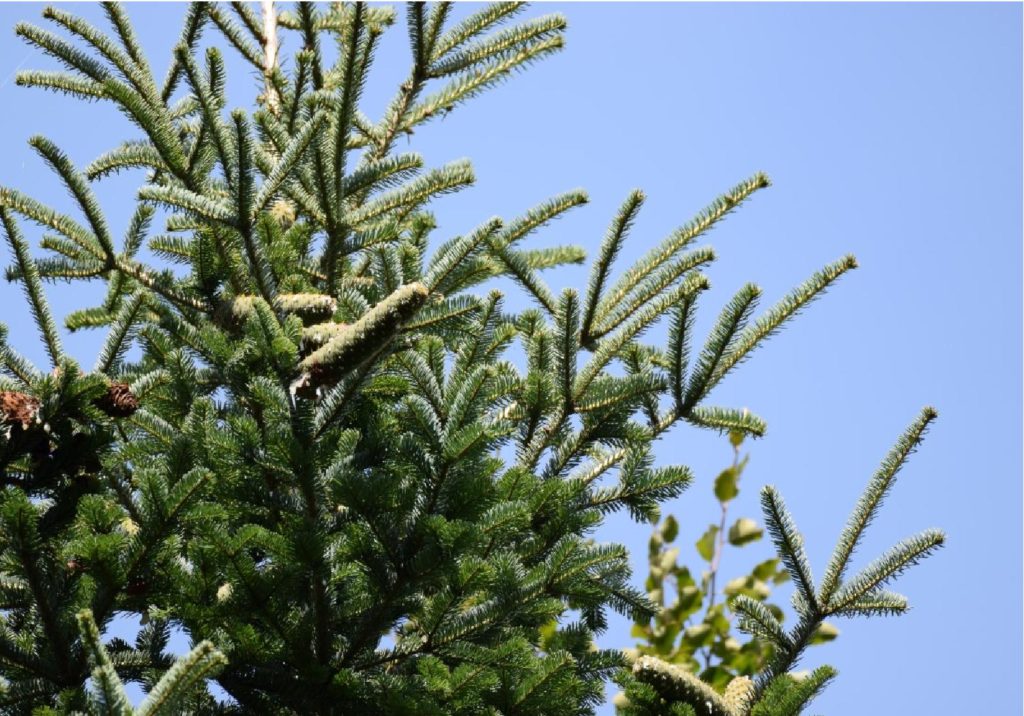



Forest tree species: Abies alba Mill.
EFT: Subalpine and mountainous spruce and mountainous mixed spruce-silver fir forest
State owned forest, management executed by the Slovenian national forests company (SiDG). The study area is under the SAC (code SI3000231) and SPA (code SI5000002) of the Natura 2000 Network named “Javorniki – Snežnik” and “Snežnik – Pivka”, respectively.
The area extends on 109,9 ha at an altitude of 1200 m a.s.l.; the ground rock material is limestone, and the soil Cromic Cambisols, Eutric Cambisols. The main species is Fagus sylvatica that covers 60%, other species present are: P. abies (25%) and A. alba (15%). According to the European forest type classification, the demonstration site is classified as “Illyrian mountainous beech forest” (EFT 7.4).
The forest is managed by irregular shelterwood system (Seed object); the stand is between 70 and 100 years old






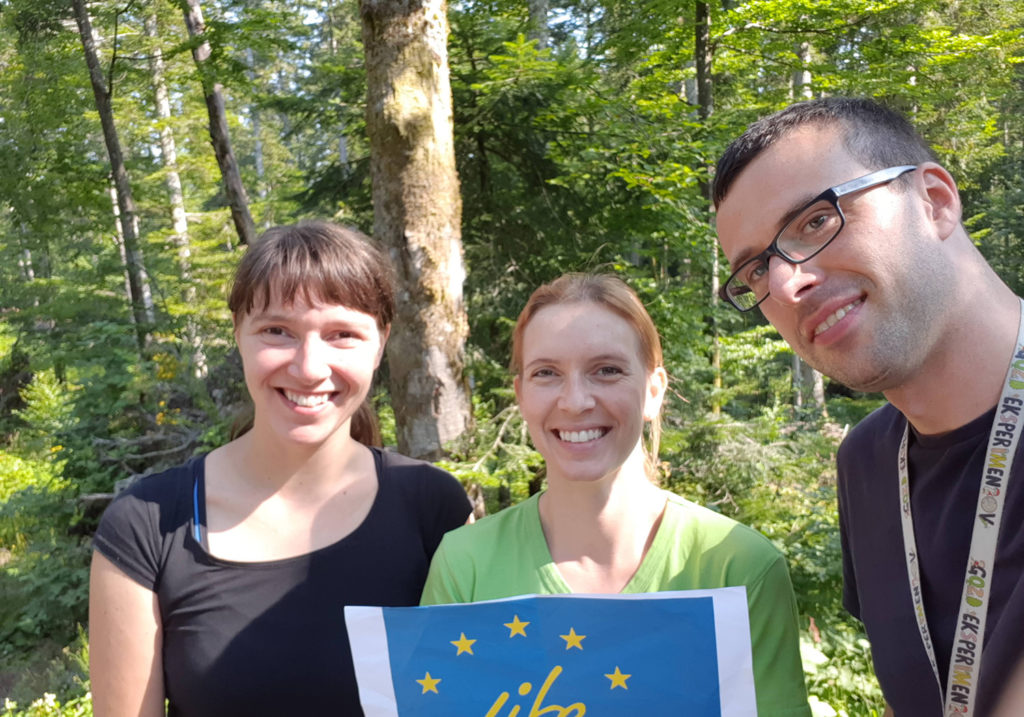

Forest tree species: Quercus robur L.
EFT: Pedunculate oak-hornbeam forest
Krakovo – Kostajevica is a private forest. The study area is under the SAC (code SI3000051) and SPA (code SI5000012) of the Natura 2000 Network named “Krakovski gozd” and “Krakovski gozd – Šentjernejsko polje”, respectively. Moreover, part of the forest is included within a strict reserve (IUCN 1) extending on 40.5 ha at an altitude around 150 m a.s.l. The ground rock material is aleurolite, and the soil is Planosol / Stagnosol. Based on a survey carried out in 2015, the main tree species is Q. robur (78.9%) mixed with Carpinus betulus (16.6%), A. glutinosa (3.8%) and other species. According to the European forest type classification, the forest is classified as “Pedunculate oak-hornbeam forest” (EFT 5.1).
The demonstration site is located inside the strict reserve, which is unmanaged, while outside the reserve the forest is managed by irregular shelterwood system. Inside the reserve the forest is uneven-aged, with trees of all ages. In 2015, the num. of trees was 76 trees/ha (64 living trees and the remaining as coarse woody debris) and the standing biomass (live and dead) was 829,4 m3/ha (693.0 m3/ha of oak).




Forest tree species: Fagus sylvatica L.
EFT: Central European mountainous beech forest
Vrbovsko is a public owned forest managed by state-owned company “Croatian Forests Ltd”. The forest extends on 37.46 ha at an altitude ranging between 430-570 m a.s.l.; the soil is “brown soil on limestone and dolomite”. Fagus sylvatica is the dominant species inside the demonstration site; according to the European forest type classification, the site is classified as “Central European mountainous beech forest” (EFT 7.2).
The number of trees (dbh>2.5 cm) is of 252 trees/ha and the wood volume is of 224 m3/ha.








Forest tree species: Abies alba Mill.
EFT: Mediterranean and Anatolian fir forest
La Verna is a monumental forest owned by Provincia Toscana di S. Francesco Stimmatizzato and managed by Unione dei Comuni Montani del Casentino. The study area falls within a SAC of the Natura 2000 named “La Verna – Monte Penna” (code IT5180101). The site is located at an altitude between 1000 and 1284 m a.s.l.; the soil is classified as Ultic Hapludalfs, fine clayey, mixed, mesic. Abies alba is the dominant tree species within the demonstration site, mixed with Fagus sylvatica; according to the European classification of forest types, the site is classified as “Mediterranean and Anatolian fir forest” (EFT 10.6).
It is an old-growth, uneven-aged, multi-layered and unmanaged forest. The number of trees (dbh>2.5 cm) is 4090 tree/ha, the wood volume is 1,050 m3/ha, the quadratic mean diameter is 40 cm, the average height is 20.40 m and the top height is 49.40 m.









